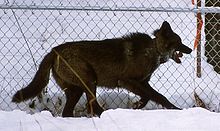





A black wolf is a melanistic colour variant of the gray wolf (Canis lupus).[1][2] Black specimens were recorded among red wolves (Canis rufus), though the colour phase in this species is not extinct yet.[3] Genetic research from the Stanford University School of Medicine and the University of California, Los Angeles revealed that wolves with black pelts owe their distinctive coloration to a mutation which occurred in domestic dogs, and was carried to wolves through wolf-dog hybridization.[1] Besides coat and knee colour, they are normal grey wolves.
- ^ a b Derr, Mark (5 February 2009). "New World Wolves and Coyotes Owe Debt to Dogs (Published 2009)". The New York Times. Archived from the original on 2021-06-09.
- ^ Molecular and Evolutionary History of Melanism in North American Gray Wolves
- ^ "Red Wolf" (PDF). canids.org. Archived from the original (PDF) on 2008-12-17.